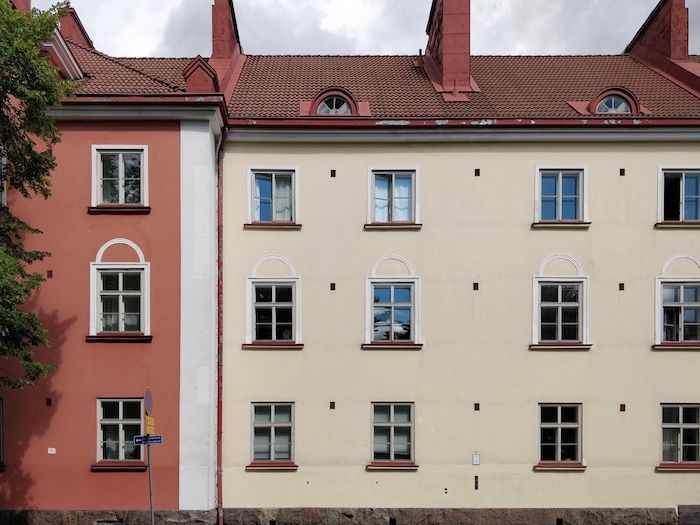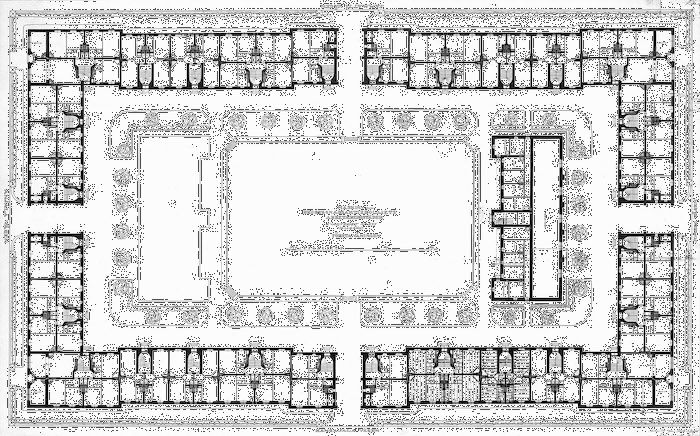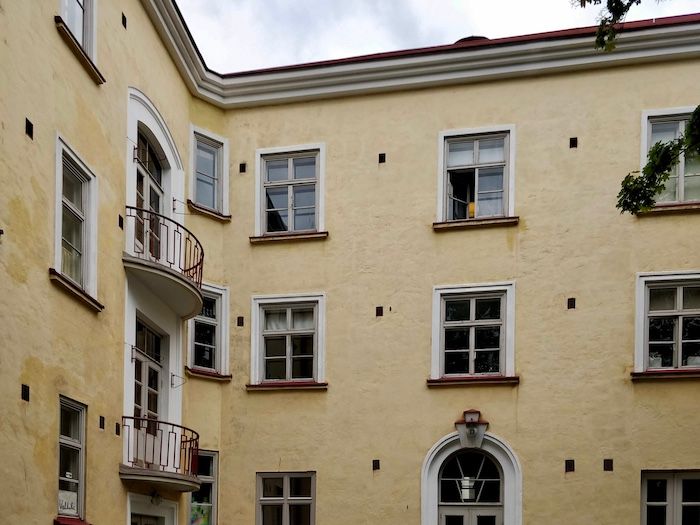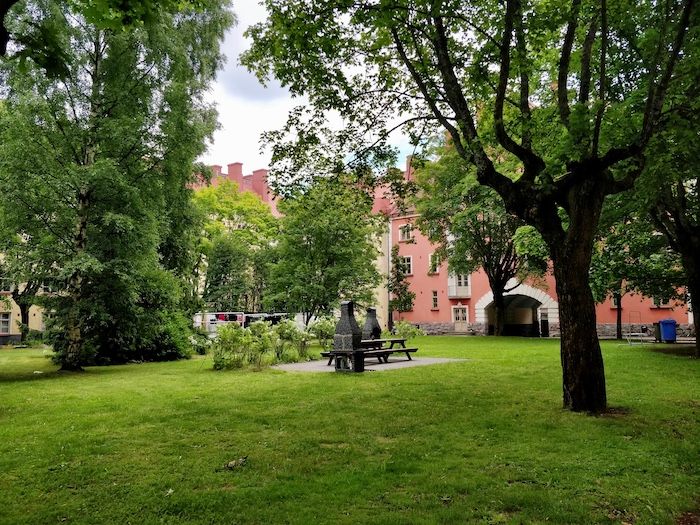The Monkey Castle: Kone and Silta Workers Housing

The Monkey Castle
I have been interested recently in early examples of social housing projects. There are some famous ones that have been well covered like Karl-Marx-Hof in Vienna, but Helsinki has a good many which are little known outside of the country.
I went to visit one such small gem in the Vallila area of Helsinki it is the Kone and Silta Workers Housing Block nicknamed Apinalinna or Monkey Castle which is a great example of early social housing in Helsinki. It shows how a good design that is well loved can resonate with its inhabitants down the generations.

Background
The building was commissioned in 1916 by Kone ja Silta Ltd when it asked Helsinki City permission to build housing for its metal workers in the Vallila district of Helsinki. I presume this is because the company had a shipyard or some sort of factory in Kalasatamaa the neighbouring harbour and industrial district at that time.
It was during WWI and housing was in short supply. Finland newly independent needed housing and Vallila was the perfect place to plan a low cost housing district for the working class as it was bordering the harbour with factories nearby.
Already there was Puu-Vallila the wooden house development built around 1910 also for workers but they are almost agrarian in nature, they remind of small town architecture in Finland from the centuries before, the Industrial Age had dawned in Finland too and they needed denser housing and urban city blocks.

Perspective (source:Finnish Architecture Navigator)
Architects
Armas Lindgren (1874-1929) and Bertel Liljequist (1885-1954) were given the commission, having worked for the company already. Elisabeth Koch (1891-1982) was responsible for the courtyard design. Armas Lindgren is the more famous of the two having being one part of the group of Architects with Herman Gesellius and Eliel Saarinen that is responsible for some of the most notable Jugendstil buildings of the time including the Central Railway Station and the National Museum of Finland. That office broke up acrimoniously with Saarinen moving very successfully to the U.S.A.

Plan source: (Finnish Architecture Navigator). The apartment block in the courtyard was never built.
History & Influences
By 1918 the first phase was completed roughly one side of the square but then the company ran out of money at the end of WWI probably negatively affected by the Russian Revolution. The next phases were built by the city in 1927 and 1929 when it was completed.
The Partnership of Lindgren and Liljequist also broke during this pause in the work with Lindgren overseeing the final phase. In the end Lindgren died before the building was finished. So it’s clear this building had anything but a smooth birth.
A number of other housing projects in Vallila were made at this time also and Europe generally mass housing projects were sprouting up.
Karl-Marx-Hof in Vienna was completed in 1930, Red Vienna had already started building apartments by 1925 so the Monkey Castle predates these just.
Kay Fishers Hornbækhus in Copenhagen 1923 is the earliest block type I know about which seems a pretty good influence on the typology of it except for the fact that the Monkey Castle was planned before this too.
Possibly closer to home in Gothenberg the Governors Housing or Landshövdingehus types which had been being built already for some time before perhaps also in Finland? Tenemant blocks in Scotland, New York, Berlin and around the world and had been around before the start of that century.
Either way this Superblock (really a normal city block but as one development) typology a Square of apartments around a shared open park space is clear here, and it was typology that emerged in Europe out of the requirement for social housing at the time.
This is such a fascinating time, the changes after WWI in technology and society with the coming of industrialisation have filtered through to new types of building typology but not yet quite through to the new style of Modernism to come. It’s the last flowering of the Beux-arts school of thought which is starting to apply its thinking to new architectural requirement for society in flux just as those factors will wash it away.

Elevations (Finnish Architecture Navigator)
The Building
The building is officially an example of Nordic Classicicm and is more classical in feel compared to the Jugendstil style which Lindgren is famous for.

Ariel View (source: Lumo.fi)
The building is still owned by two separate companies so the division in the building phases and ownership at least seems to also have endured through to today.
The Inner Courtyard, the biggest in Finland was designed by Elisabeth Koch who was also active in many projects around the city. The Maples on the perimeter of the Courtyard and much of the planting are still present today from her design. During WWII the central courtyard was given over to growing vegetables
The building acquired the nickname Apinalinna or Monkey Castle probably originating from the 1950’s when 750 residents were crammed into 180 apartments, but although the overcrowding has gone the nickname stuck.

Critisism
The plan is on an 11m wide grid and two apartments deep. All accessed by staircases off of the inner courtyard. There are four main entrances one each in the centre of each facade of the building. These are articulated almost like castle keeps it’s really a nice pleasing touch. Access to the apartments is by stairs whose entrance is from the courtyard
It’s interesting though that although the main form in very Jugendstil the detailing is more classical. Stylings in the building are a little disembodied, they feel like quotations it’s almost post-modern in its styling however this restrained classicism is of the time.
The perspective is from 1919 and does not show any classical detailing but the elevations dated 1927 do. May the building have been developed in that time in a slightly more classical direction? Either way the composition is balanced really nicely.

The apartments are one room or two room with a kitchen and all with a stove. The apartments mostly have single outlooks so there is no cross ventilation possible, they are packed tightly by no means are they luxury flats.
Going round the building we got talking to a resident who showed us into the courtyard and was obviously proud of the building the space has a great atmosphere, it was calm but clearly full of life. The Courtyard is the biggest in Finland and is surrounded by Maple trees. While many central courtyards today are filled with car parking this is a calm oasis of nature, protected from the street noise around.

Vallila today is gentrifying, it’s pretty clear to me from a walk around the area with the new shops and cafes sprouting up here and there. Next to Kaalasatamaa a huge new redevelopment of the harbor next door I can see the speed of this process only increasing. It’s not completely turned yet, there were a healthy number of drunks hanging out in the parks and a sense from some other episodes that happened around us during the walk this area is still raw. Hopefully this areas rawness doen’t fade entirely. I think the Monkey Castle is here to stay though.
Basic Info
- Workers Housing for Kone and Silta Ltd.
- Architects: Armas Lindgren (1874-1929), Bertel Liljequist (1885-1954), Elisabeth Koch (1891-1982)
- Apartments: 180
- Completion: 1918, 1927, 1929
- Address: Somerontie 14, 00550, Helsinki, Finland
Further Reading
- The Finnish Architecture Navigator has a nice post on the Workers Housing Building.
- Article about the building by Lumo one of the companies that looks after some of the apartments nowadays.